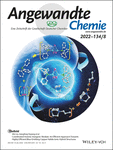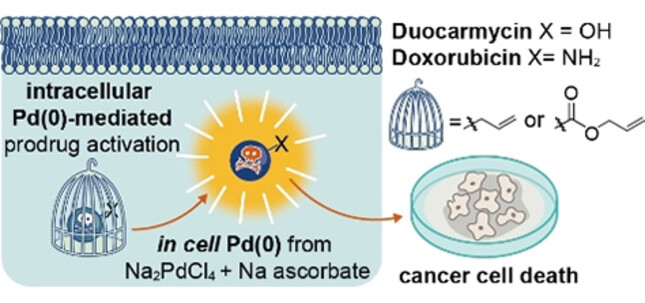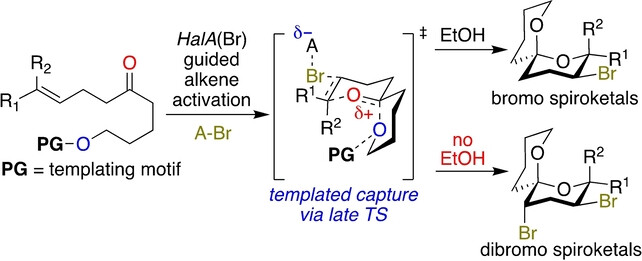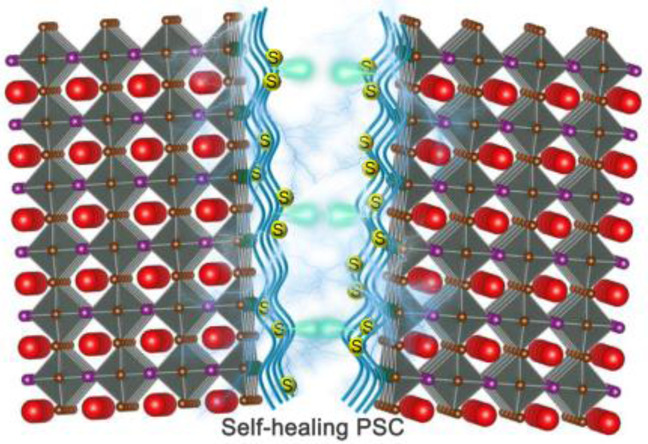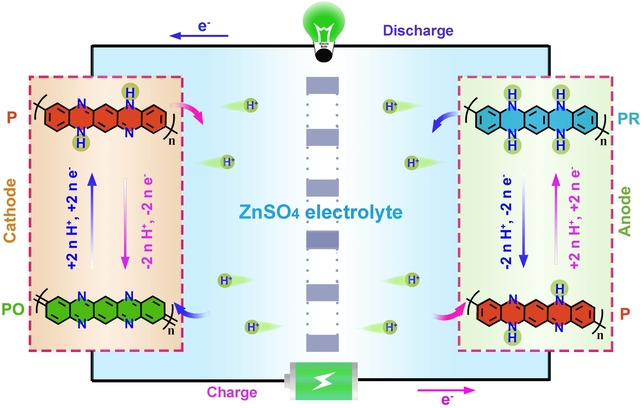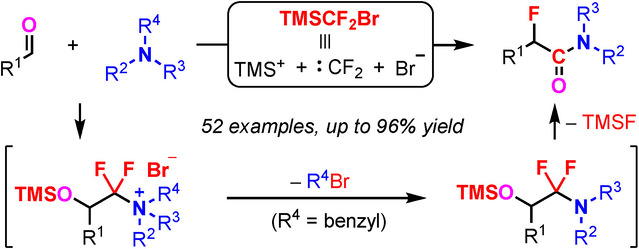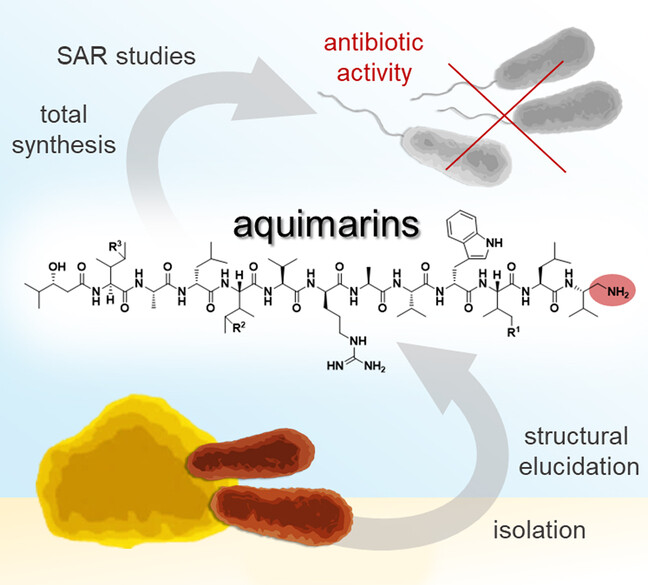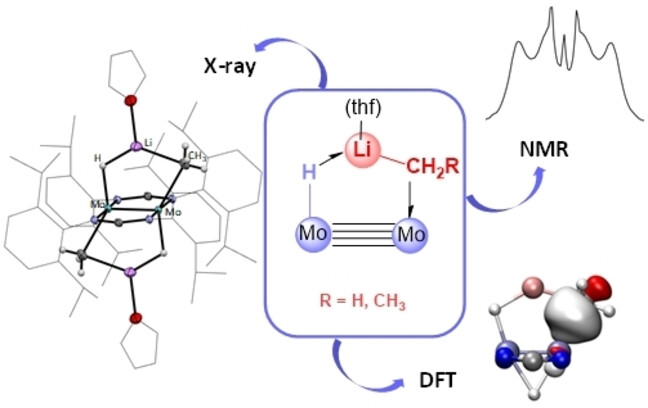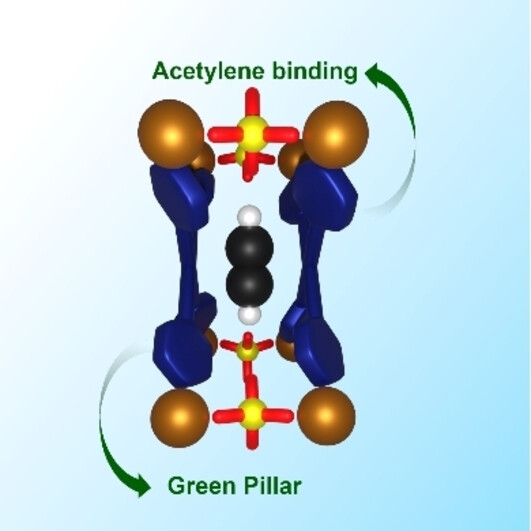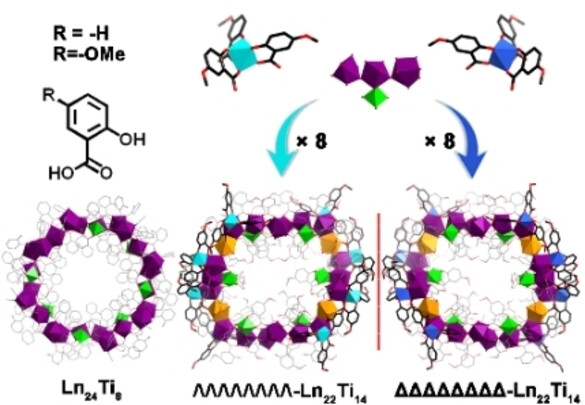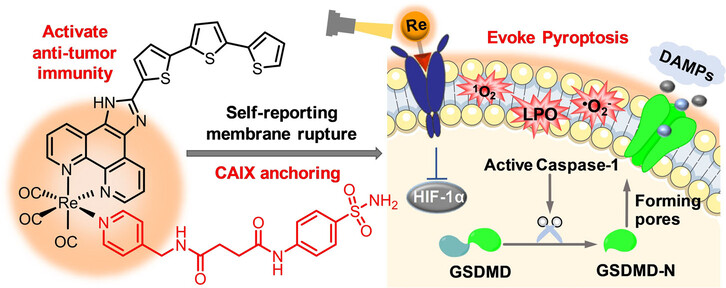Journal list menu
Export Citations
Download PDFs
Titelbild
Titelbild: Coordinated Anionic Inorganic Module—An Efficient Approach Towards Highly Efficient Blue-Emitting Copper Halide Ionic Hybrid Structures (Angew. Chem. 8/2022)
- First Published: 27 January 2022
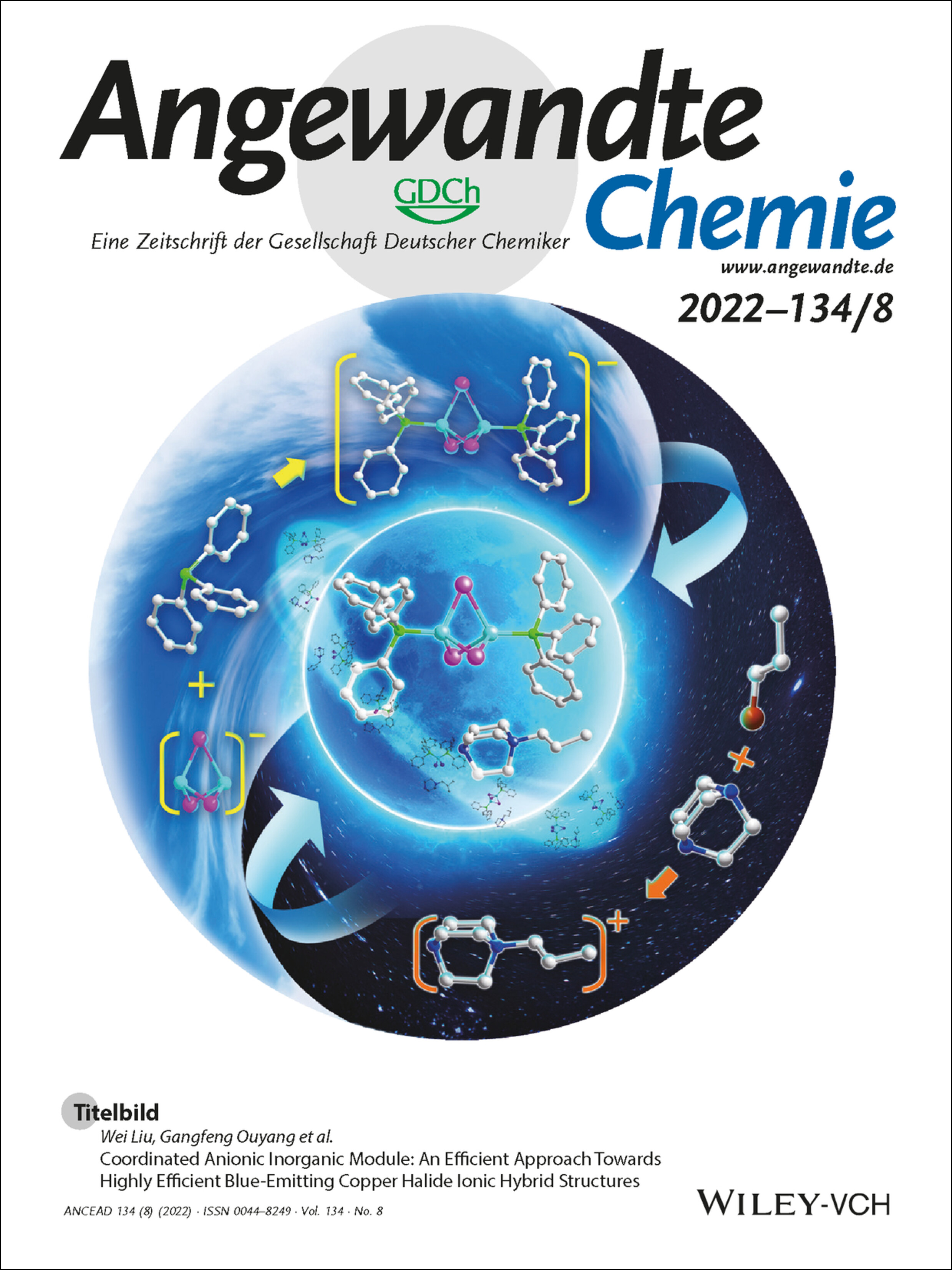
Organisch-anorganische Hybridstrukturen auf Kupferhalogenidbasis haben ein großes Potenzial als lichtemittierende Materialien. In ihrem Forschungsartikel (e202115225) berichten Wei Liu, Gangfeng Ouyang et al. über eine einfache Strategie für die Synthese von stark lumineszierenden Kupferhalogenid-Hybridstrukturen durch Herstellung eines koordinierten anionischen anorganischen Moduls mit einem neutralen organischen Ligandenmolekül. Mit diesem Ansatz wurde eine Familie blau leuchtender Kupferhalogenid-Hybridstrukturen mit hohen internen Quantenausbeuten von bis zu 98 % hergestellt.
Innentitelbild: Highly Accurate Synthesis of Quasi-sub-nanoparticles by Dendron-assembled Supramolecular Templates (Angew. Chem. 8/2022)
- First Published: 27 January 2022
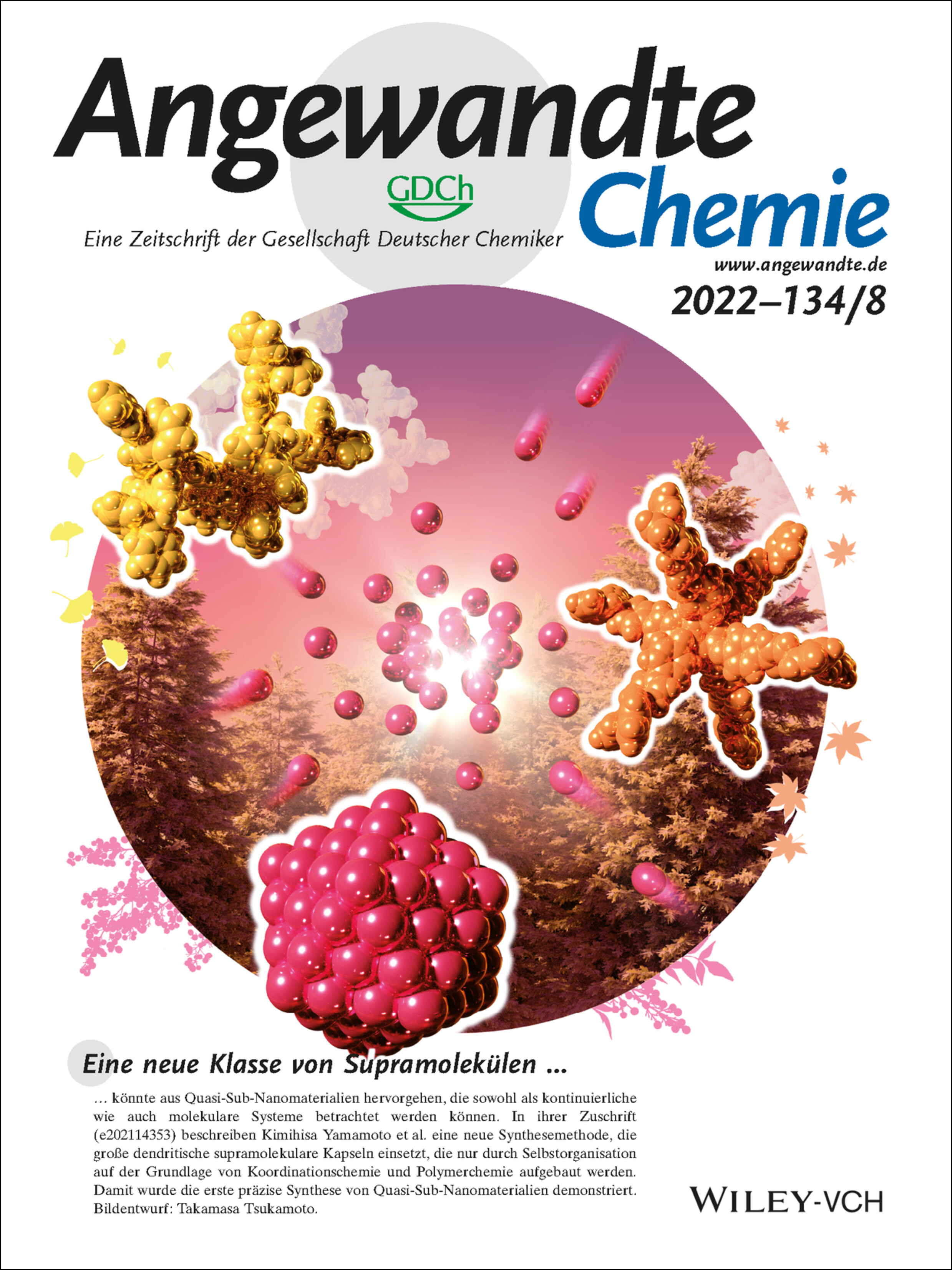
Eine neue Klasse von Supramolekülen könnte aus Quasi-Sub-Nanomaterialien hervorgehen, die sowohl als kontinuierliche wie auch molekulare Systeme betrachtet werden können. In ihrer Zuschrift (e202114353) beschreiben Kimihisa Yamamoto et al. eine neue Synthesemethode, die große dendritische supramolekulare Kapseln einsetzt, die nur durch Selbstorganisation auf der Grundlage von Koordinationschemie und Polymerchemie aufgebaut werden. Damit wurde die erste präzise Synthese von Quasi-Sub-Nanomaterialien demonstriert. Bildentwurf: Takamasa Tsukamoto.
Innenrücktitelbild: A Carbonic Anhydrase IX (CAIX)-Anchored Rhenium(I) Photosensitizer Evokes Pyroptosis for Enhanced Anti-Tumor Immunity (Angew. Chem. 8/2022)
- First Published: 28 January 2022
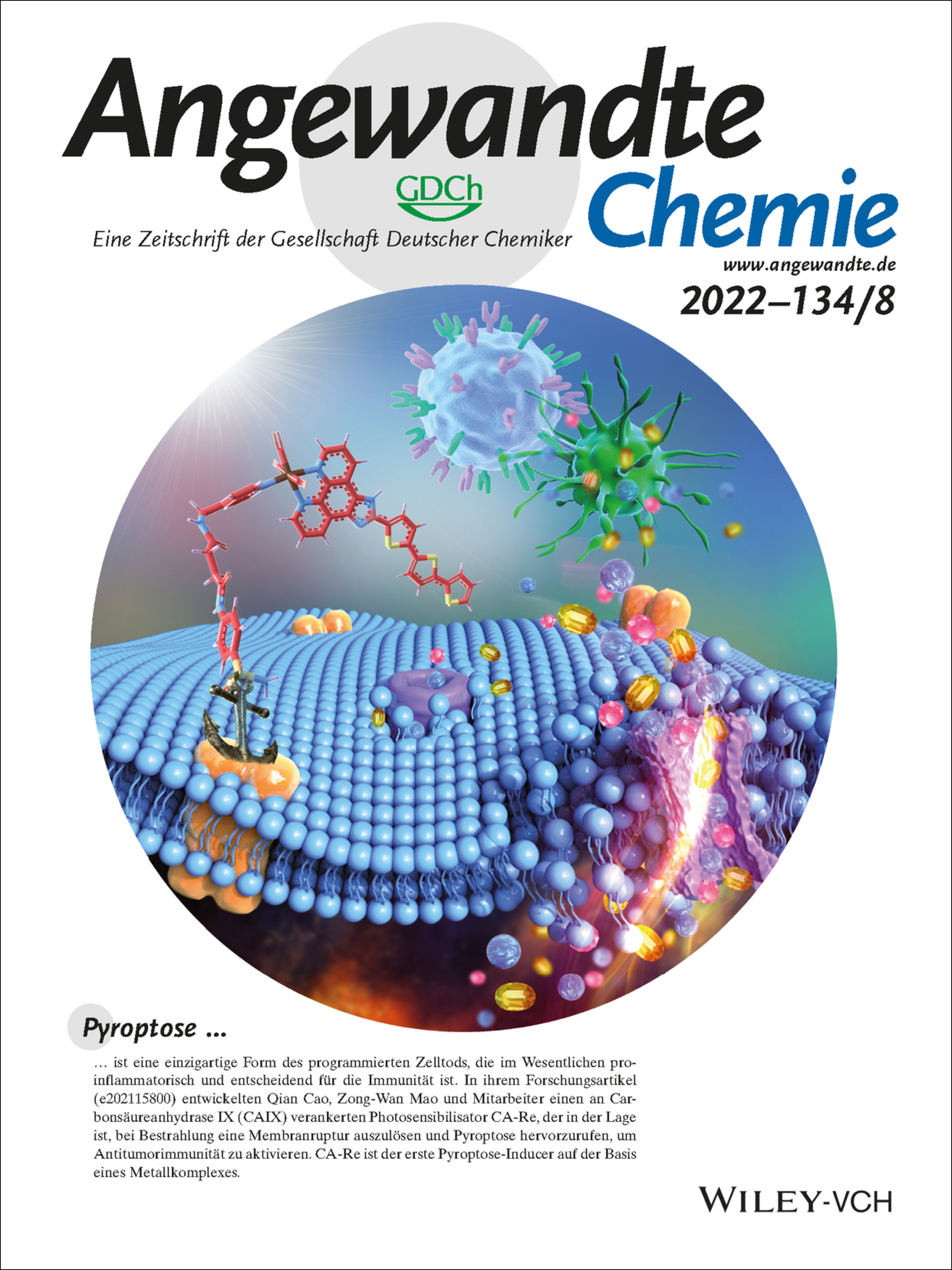
Pyroptose ist eine einzigartige Form des programmierten Zelltods, die im Wesentlichen proinflammatorisch und entscheidend für die Immunität ist. In ihrem Forschungsartikel (e202115800) entwickelten Qian Cao, Zong-Wan Mao und Mitarbeiter einen an Carbonsäureanhydrase IX (CAIX) verankerten Photosensibilisator CA-Re, der in der Lage ist, bei Bestrahlung eine Membranruptur auszulösen und Pyroptose hervorzurufen, um Antitumorimmunität zu aktivieren. CA-Re ist der erste Pyroptose-Inducer auf der Basis eines Metallkomplexes.
Rücktitelbild: Gene Fusion and Directed Evolution to Break Structural Symmetry and Boost Catalysis by an Oligomeric C−C Bond-Forming Enzyme (Angew. Chem. 8/2022)
- First Published: 18 January 2022
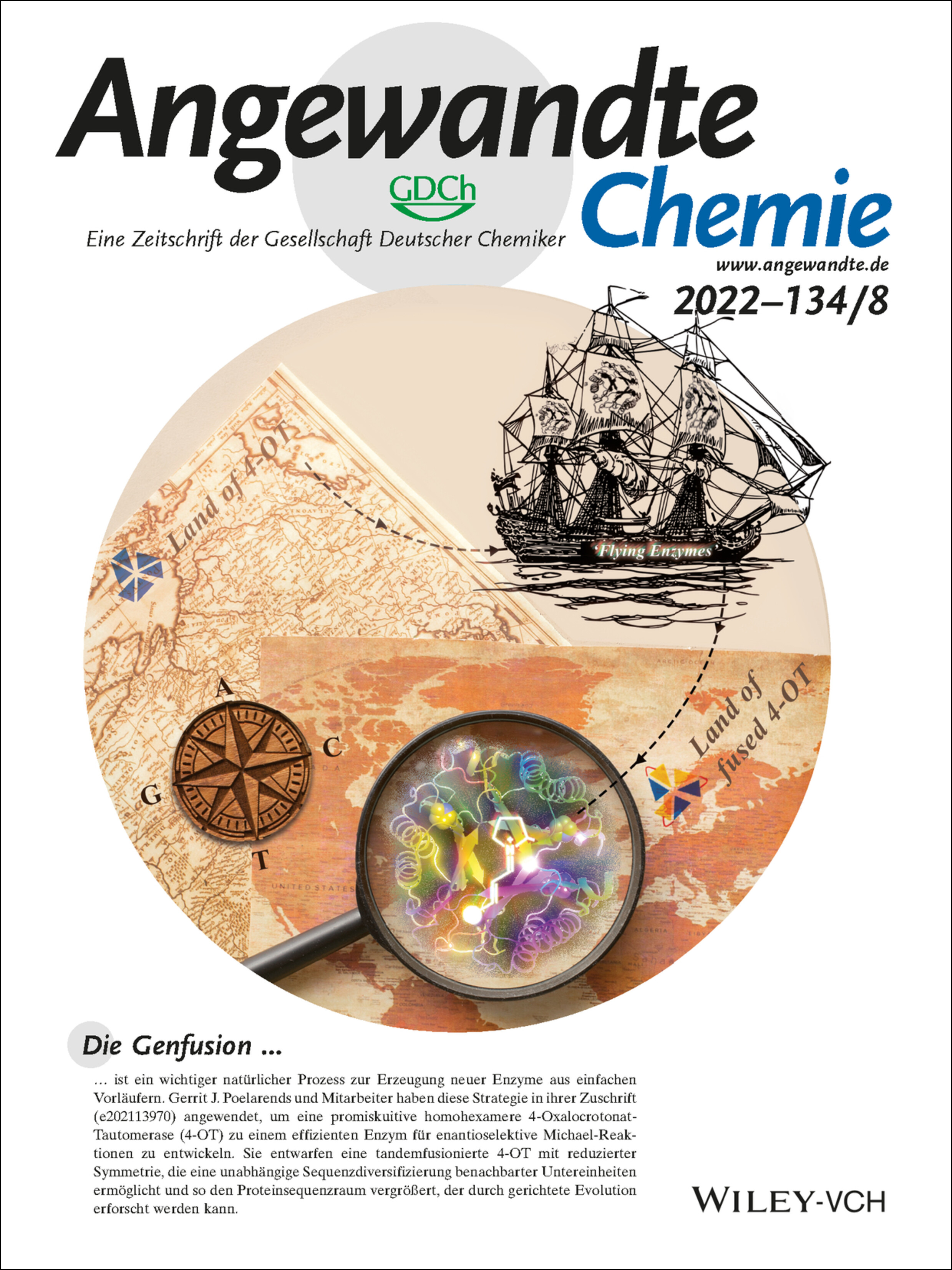
Die Genfusion ist ein wichtiger natürlicher Prozess zur Erzeugung neuer Enzyme aus einfachen Vorläufern. Gerrit J. Poelarends und Mitarbeiter haben diese Strategie in ihrer Zuschrift (e202113970) angewendet, um eine promiskuitive homohexamere 4-Oxalocrotonat-Tautomerase (4-OT) zu einem effizienten Enzym für enantioselektive Michael-Reaktionen zu entwickeln. Sie entwarfen eine tandemfusionierte 4-OT mit reduzierter Symmetrie, die eine unabhängige Sequenzdiversifizierung benachbarter Untereinheiten ermöglicht und so den Proteinsequenzraum vergrößert, der durch gerichtete Evolution erforscht werden kann.
Frontispiz
Frontispiz: Vektorielle Katalyse mit oberflächenverankerten nano-metallorganischen Gerüsten in mikrofluidischen Reaktoren
- First Published: 07 February 2022
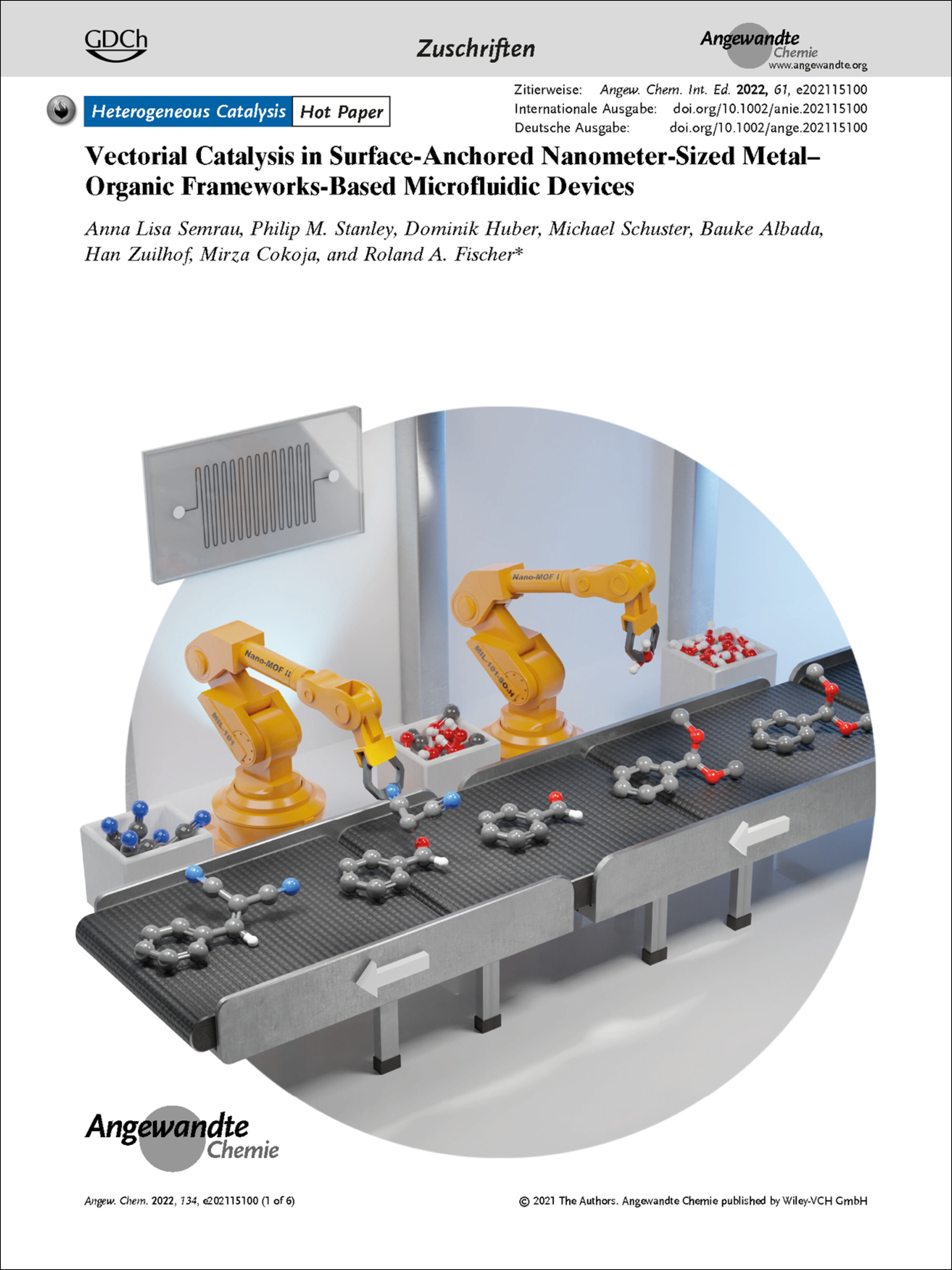
Metallorganische Gerüstverbindungen In ihrer Zuschrift (e202115100) berichten Roland A. Fischer et al. über die Entwicklung eines Mikrofluidikelements auf der Basis oberflächenverankerter metallorganischer Gerüststrukturen für Anwendungen in der vektoriellen Katalyse.
Frontispiz: Thermo- and Mechanochromic Camouflage and Self-Healing in Biomimetic Soft Actuators Based on Liquid Crystal Elastomers
- First Published: 07 February 2022
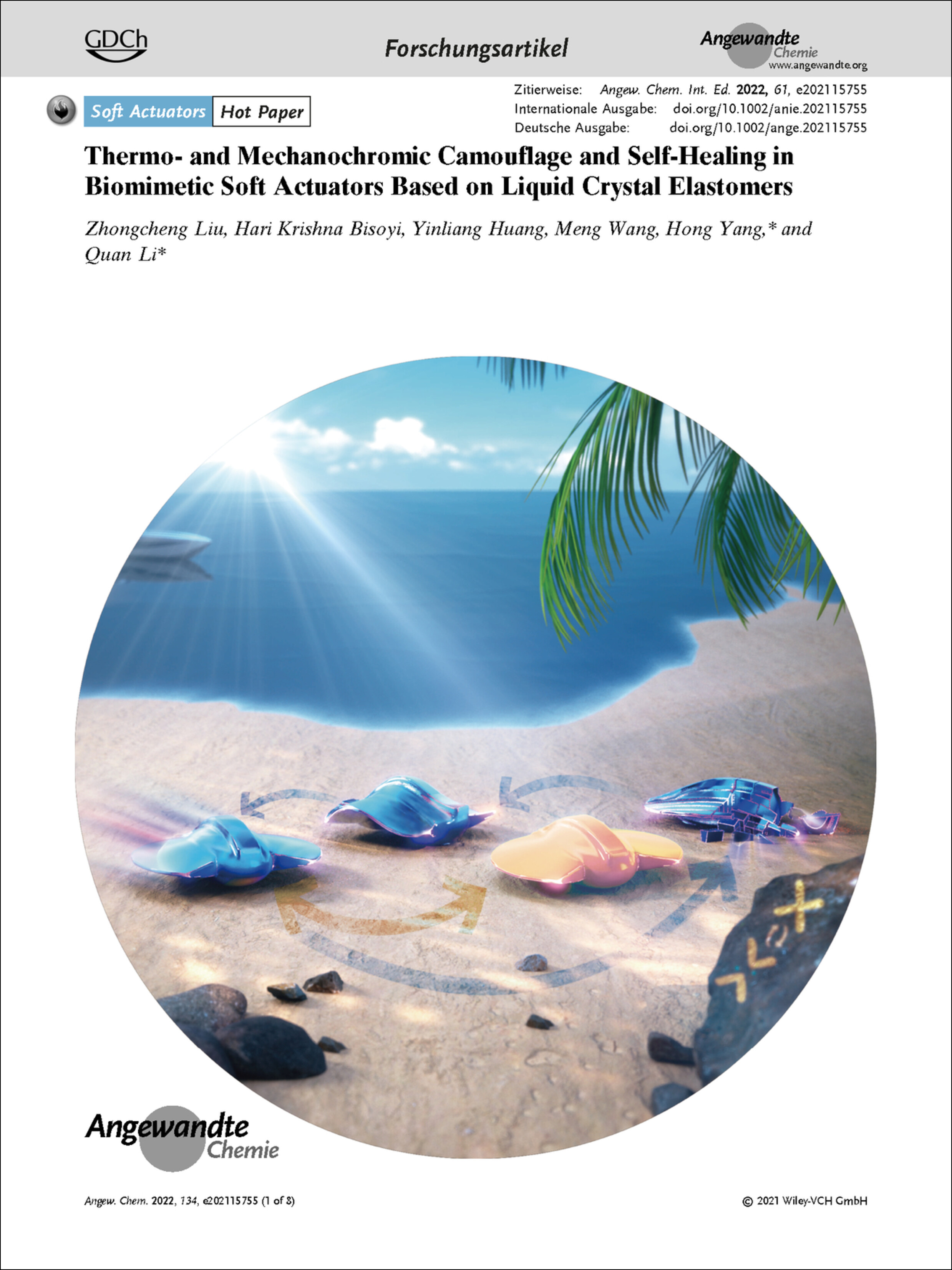
Weiche Aktoren In ihrem Forschungsartikel (e202115755) berichten Hong Yang, Quan Li et al. über die thermo- und mechanochrome Tarnung und Selbstheilung in biomimetischen weichen Aktoren basierend auf Flüssigkristallelastomeren.
Graphisches Inhaltsverzeichnis
Graphisches Inhaltsverzeichnis: Angew. Chem. 8/2022
- First Published: 07 February 2022
Introducing …
Hajime Shigemitsu
- First Published: 21 December 2021

“The natural talent I would like to be gifted with is the communication ability to make a good relationship with any person in the world … Key experiences in my education / career were the extensive discussions with my respected mentors …” Find out more about Hajime Shigemitsu in his Introducing … Profile.
Highlights
Molecular Machines
A Molecular Pump Facilitates Mechanical Adsorption Away from Equilibrium
- First Published: 27 January 2022
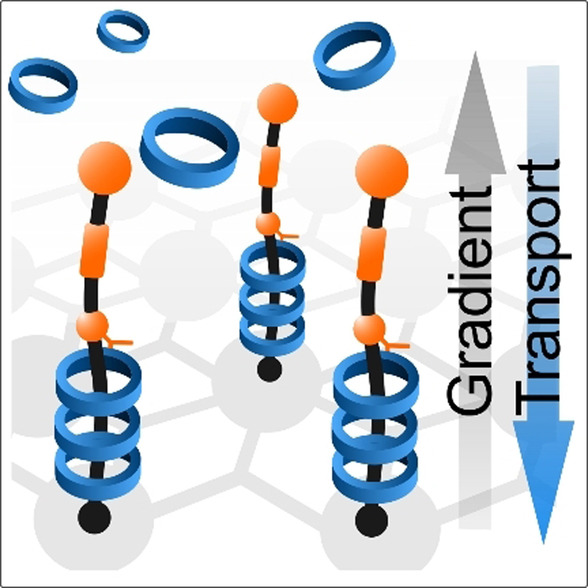
Attaching or embedding biological or artificial molecular pumps to or into a surface or interface to achieve compartmentalization enables their unidirectional molecular motion to be organized in a confined environment. This approach led to the discovery of the phenomenon of mechanisorption and paves the way towards building highly complex organized molecular architectures.
Kurzaufsätze
DNA Nanotechnology
Framework Nucleic Acids in Nuclear Medicine Imaging: Shedding Light on Nano–Bio Interactions
- First Published: 29 October 2021
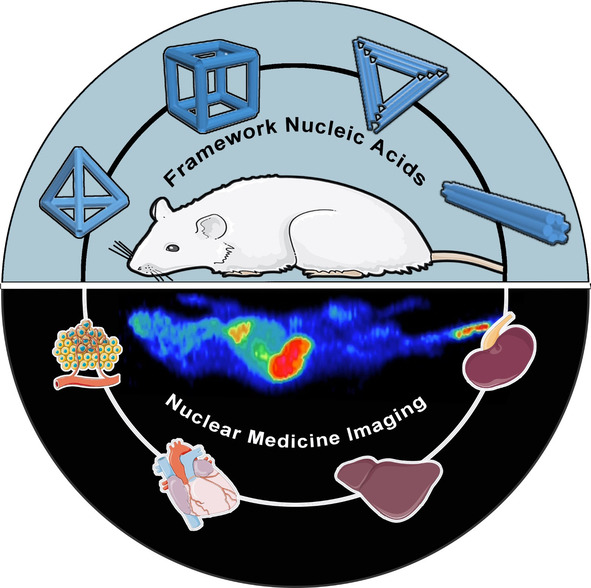
The field of framework nucleic acids (FNAs) has been advancing in biomedicine over the past decade. Its recent integration with nuclear medicine imaging has broadened our understanding of the bio-interfacing of FNAs. In this Minireview, we survey and discuss nuclear imaging of FNAs in vivo with the aim of highlighting outstanding questions on nano–bio interactions and potential directions for translation.
Aufsätze
Molecularly Imprinted Polymers
Fighting Antibiotic-Resistant Bacteria: Promising Strategies Orchestrated by Molecularly Imprinted Polymers
- First Published: 15 November 2021
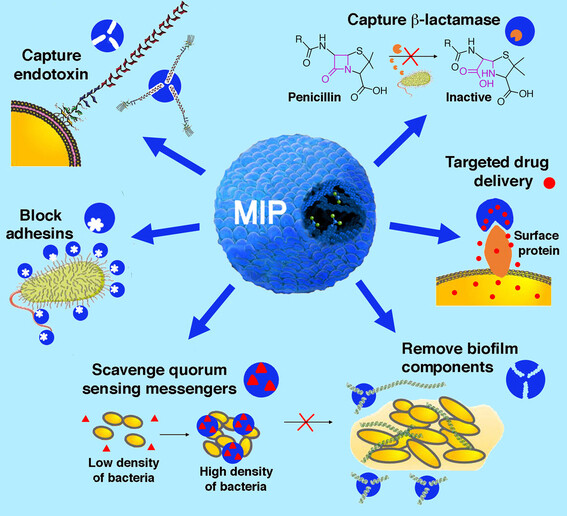
Persistent infections and deaths caused by antibiotic-resistant bacteria are a worldwide health issue. Molecularly imprinted polymers that are antibody mimics with selective recognition sites for a target molecule can fight these bacteria on several fronts. The targets range from endotoxins, β-lactamase and adhesins to biofilm components and quorum sensing messengers.
Zuschriften
Heterogene Katalyse | Hot Paper
Vektorielle Katalyse mit oberflächenverankerten nano-metallorganischen Gerüsten in mikrofluidischen Reaktoren
- First Published: 26 November 2021
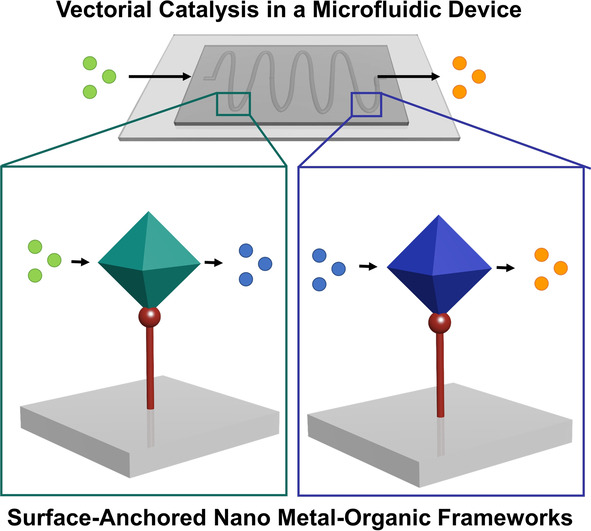
Die gezielte Steuerung mehrstufiger Reaktionen mit definierter räumlicher Anordnung ist ein Kernziel der Katalyse, das unter dem Begriff vektorielle Katalyse zusammengefasst wird. Wir zeigen ein Grundsatzbeweis für ein metallorganisches Gerüst (MOF)-basiertes vektorielles Katalysesystem, indem wir zwei verschiedene Nano-MOFs an präzisen räumlichen Positionen in einem mikrofluidischen Reaktor verankern und ihre Leistung bei der Katalyse einer zweistufigen Reaktionsfolge untersuchen.
CO2 Valorization
Electrical Reverse Shift: Sustainable CO2 Valorization for Industrial Scale
- First Published: 21 December 2021
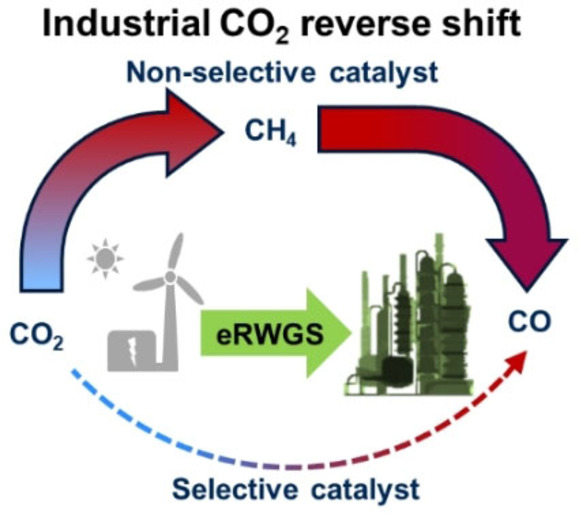
Electrified reverse water-gas-shift (eRWGS™) enables production of sustainable carbon-based chemicals from CO2 compatible with existing industrial processes. Herein we demonstrate the advantages of a methanation active catalyst, including superior activity, favorable temperature profile, and suppression of carbon formation.
Polymeric Nanoparticles | Very Important Paper
Transformer-Induced Metamorphosis of Polymeric Nanoparticle Shape at Room Temperature
- First Published: 10 January 2022

The shape of nanoparticles is a crucial parameter that affects their fundamental properties. Herein, we report a straightforward approach wherein addition of a small organic molecule (transformer) can induce metamorphosis of the nanoparticle shape without altering the chemical structure of the constituent polymers. Importantly, this method is applicable to various block copolymers without requiring the synthesis of stimuli-responsive polymers.
Bioorthogonal Chemistry | Hot Paper
Controlled In-Cell Generation of Active Palladium(0) Species for Bioorthogonal Decaging
- First Published: 05 November 2021
Carbenes | Very Important Paper
Hydrogenative Cycloisomerization and Sigmatropic Rearrangement Reactions of Cationic Ruthenium Carbenes Formed by Catalytic Alkyne gem-Hydrogenation
- First Published: 15 December 2021
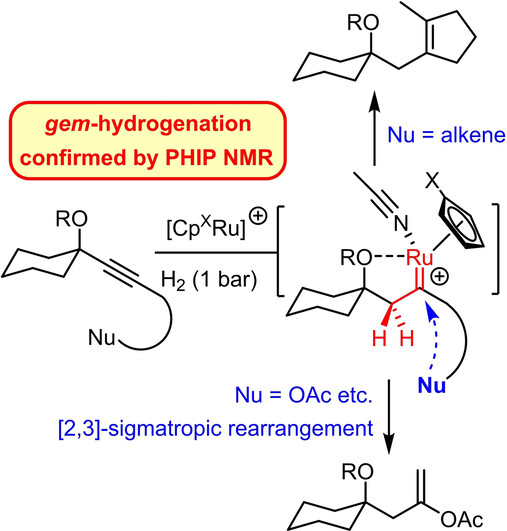
Two unprecedented hydrogenation reactions are disclosed, commencing with geminal delivery of both H-atoms of H2 to the triple bond of a propargyl alcohol derivative. When catalyzed with cationic ruthenium complexes, the resulting pianostool carbenes are so “hot” that they are readily intercepted by tethered nucleophiles, resulting in cycloisomerization or [2,3]-sigmatropic rearrangement reactions.
Biocatalysis | Hot Paper
Gene Fusion and Directed Evolution to Break Structural Symmetry and Boost Catalysis by an Oligomeric C−C Bond-Forming Enzyme
- First Published: 10 December 2021

Less symmetry, more diversity: Here we show that gene duplication and fusion to break structural symmetry, allowing independent sequence diversification of neighboring subunits by directed evolution, is a powerful strategy to boost catalysis by a promiscuous homohexameric 4-oxalocrotonate tautomerase (4-OT), enabling efficient asymmetric Michael additions.
Dendrimers | Very Important Paper
Highly Accurate Synthesis of Quasi-sub-nanoparticles by Dendron-assembled Supramolecular Templates
- First Published: 10 January 2022

“Dendron-assembled supramolecules” constructed by self-assembly based on coordination chemistry and polymer chemistry serve as flexibly designable supramolecular huge templates and demonstrate the first-ever precise synthesis of quasi-sub-nanomaterials. This concept for the creation of larger inorganic nanomaterials using even larger organic molecules will provide a crucial key to exploring the last frontier in nanoscience.
Photochemistry
Controlling Chemoselectivity of Catalytic Hydroboration with Light
- First Published: 14 December 2021
Cyclization
A Mechanistically Inspired Halenium Ion Initiated Spiroketalization: Entry to Mono- and Dibromospiroketals
- First Published: 08 December 2021
Polycycles
12b,24b-Diborahexabenzo[a,c,fg,l,n,qr]pentacene: A Low-LUMO Boron-Doped Polycyclic Aromatic Hydrocarbon
- First Published: 16 December 2021
![12b,24b-Diborahexabenzo[a,c,fg,l,n,qr]pentacene: A Low-LUMO Boron-Doped Polycyclic Aromatic Hydrocarbon](/cms/asset/3a066461-ed41-476a-a019-bf86462f8960/ange202115746-toc-0001-m.jpg)
A doubly B-doped hexabenzopentacene was designed based on presynthetic DFT calculations, predicting intriguing optoelectronic properties. Subsequently, the electron-deficient, NIR-emitting B-doped polycyclic aromatic hydrocarbon was prepared via six net C−H borylations from an unfunctionalized alkene in a two-pot synthetic procedure. The structure obtained by X-ray crystallography confirmed an enhanced π-conjugation upon cyclization compared to non-fused derivatives.
Cyclopropanation | Very Important Paper
Dearomative Cyclopropanation of Naphthols via Cyclopropene Ring-Opening
- First Published: 22 December 2021

The rhodium- and acid-catalyzed dearomative cyclopropanation of naphthols from cyclopropene ring-opening has been described. The reaction is scalable and highly chemoselective, and the vinyl cyclopropane products can be uniquely diversified. Experimental and computational studies support the proposed mechanism.
Solar Cells
Thermal-Triggered Dynamic Disulfide Bond Self-Heals Inorganic Perovskite Solar Cells
- First Published: 21 December 2021
Forschungsartikel
Soft Actuators | Hot Paper
Thermo- and Mechanochromic Camouflage and Self-Healing in Biomimetic Soft Actuators Based on Liquid Crystal Elastomers
- First Published: 13 December 2021
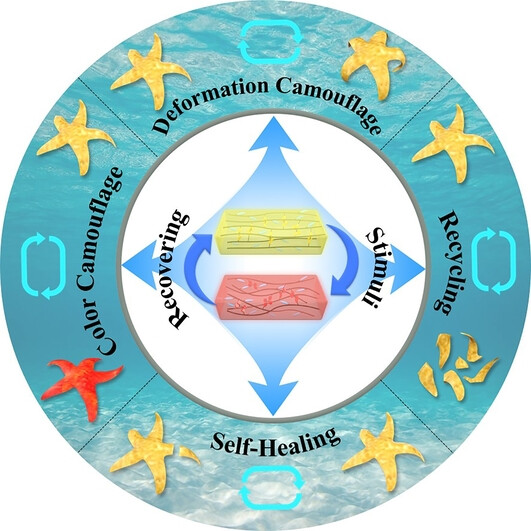
A multi-stimuli-responsive tetraarylsuccinonitrile (TASN) chromophore is chemically introduced into a liquid crystal elastomer (LCE) network through a facile thiol-ene photoaddition method. The obtained TASN-LCE soft actuators not only exhibit reversible shape-morphing and reversible color-changing behavior in response to heat and mechanical compression, but also have excellent self-healing, reprogramming and recycling characteristics.
Mg-Ion Batteries
Synthesis and Characterization of Magnesium Vanadates as Potential Magnesium-Ion Cathode Materials through an Ab Initio Guided Carbothermal Reduction Approach
- First Published: 01 December 2021
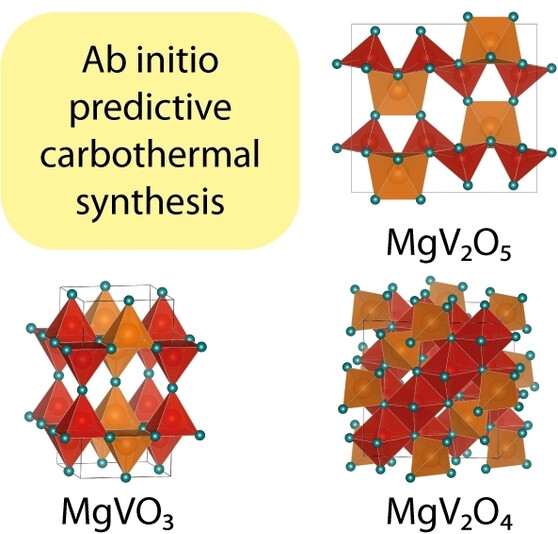
Ab initio prediction of thermodynamic parameters leads to a predictive synthesis strategy utilizing solid carbon for facile preparation of a series of magnesium vanadate compounds. 25Mg solid-state NMR spectroscopy of these compounds is shown to be a practical way for characterizing their local Mg structures.
Biocatalysis
One-Pot Biocatalytic In Vivo Methylation-Hydroamination of Bioderived Lignin Monomers to Generate a Key Precursor to L-DOPA
- First Published: 09 December 2021

Protein and strain engineering combined. The combination of two engineered enzymes (a methyltransferase and an ammonia lyase) and an engineered E. coli strain (for regeneration of the SAM cofactor) has been developed to enable a fully biocatalytic one-pot methylation–hydroamination cascade. As an example, the synthesis of l -veratrylglycine from renewable lignin-derived ferulic acid has been demonstrated, in high yield and excellent ee.
Zeolite Synthesis
Enhanced Selectivity and Stability of Finned Ferrierite Catalysts in Butene Isomerization
- First Published: 07 December 2021
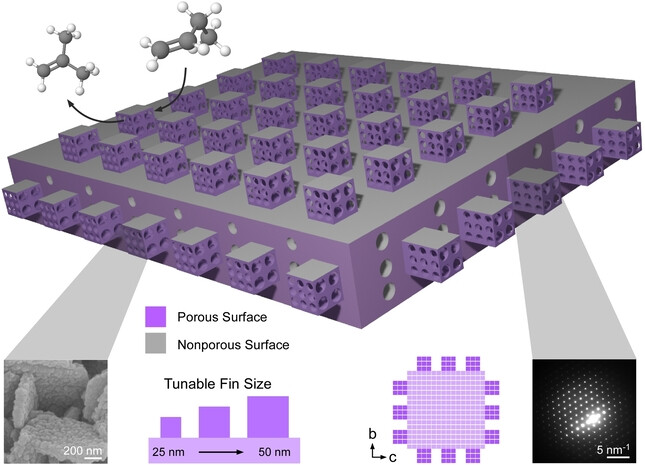
The synthesis of finned ferrierite produces a zeolite with reduced mass transport limitations, thereby enhancing its catalyst lifetime and increasing its selectivity to isobutene in tests of 1-butene isomerization. These findings highlight the advantages of introducing fins through facile and tunable post-synthesis modification to impart material properties that are otherwise unattainable by conventional synthesis methods.
Helicenes
A Near-Infrared Absorbing and Emissive Quadruple Helicene Enabled by the Scholl Reaction of Perylene
- First Published: 17 December 2021
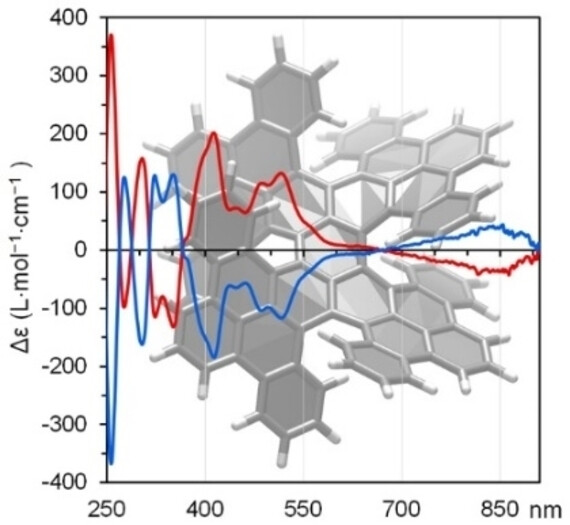
A novel quadruple helicene having two [6] and two [7]helicene moieties fused in a contorted framework was synthesized by the Scholl reaction of a perylene-containing substrate. The quadruple helicene exhibits unusual near-infrared absorption and emission and its isolated enantiomers exhibit electronic circular dichroism in the near-infrared and visible-light regions.
Electrocatalysis
Ordered PtFeIr Intermetallic Nanowires Prepared through a Silica-Protection Strategy for the Oxygen Reduction Reaction
- First Published: 10 December 2021
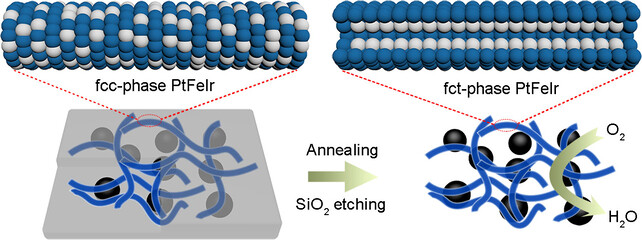
Ordered PtFeIr intermetallic nanowires supported on commercial carbon were synthesized. Coating with SiO2 and the addition of Ir enabled the integrity of the nanowire structure to be maintained during their transformation from a disordered fcc-phase to an ordered fct-phase. The fct-phase nanowires exhibited much better ORR activity and structural and electrochemical stability than the fcc-phase ones.
Copolymerization
Degradable Vinyl Random Copolymers via Photocontrolled Radical Ring-Opening Cascade Copolymerization
- First Published: 10 December 2021
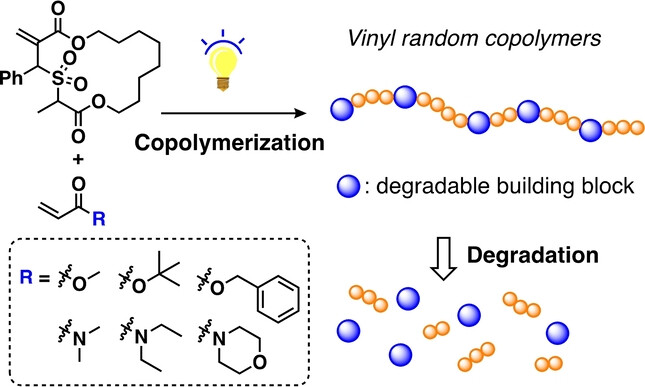
A general approach to degradable vinyl random copolymers via photocontrolled radical ring-opening cascade copolymerization (rROCCP) is developed. A variety of acrylates or acrylamides can be copolymerized with the macrocyclic allylic sulfone with near-unity comonomer reactivity ratios at all feed compositions. The unusual reversible inhibition of chain propagation by sulfur dioxide in rROCCP was resolved by reducing the solubility of sulfur dioxide.
Biocatalysis
Functional Characterization and Protein Engineering of a Triterpene 3-/6-/2′-O-Glycosyltransferase Reveal a Conserved Residue Critical for the Regiospecificity
- First Published: 10 December 2021
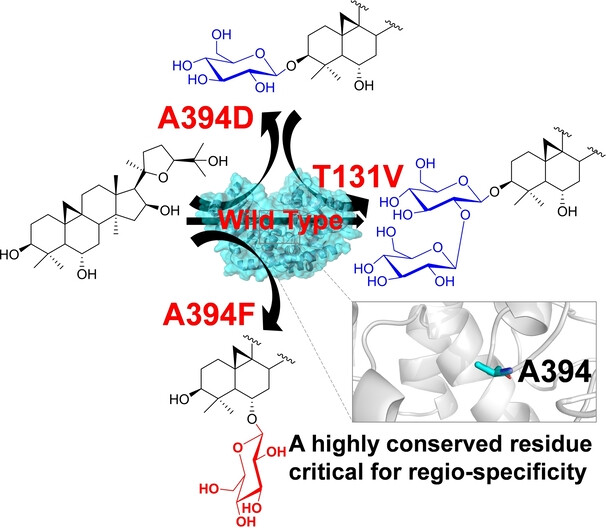
We characterized the first plant cycloartane glycosyltransferase AmGT8 from A. membranaceus. Its mutants A394F, A394D, and T131V were discovered using semi-rational design, which showed specific 6-O, 3-O, and 2′-O glycosylation activities, respectively. This study uncovered a conserved residue critical for the regiospecificity of plant glycosyltransferases.
Catalytic Therapy | Hot Paper
A Nanohook-Equipped Bionanocatalyst for Localized Near-Infrared-Enhanced Catalytic Bacterial Disinfection
- First Published: 26 November 2021
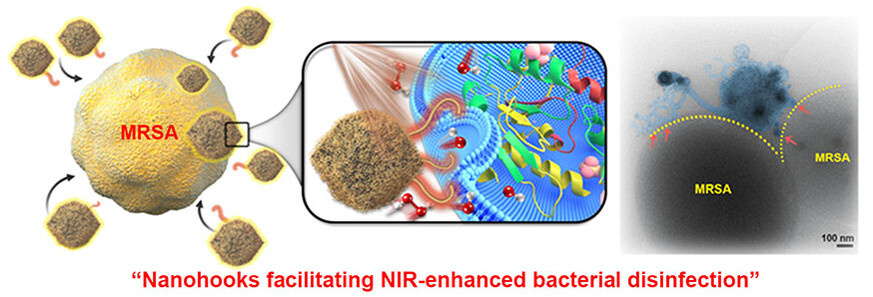
A nanohook-equipped bionanocatalyst can firstly hook to bacteria and biofilm, then catalyze H2O2 to generate toxic hydroxyl radicals for localized disinfection. Upon the near-infrared laser irradiation, the bionanocatalyst can generate heat, which simultaneously accelerates the catalytic therapy and enables the heat ablation against bacteria.
Solar Cells
Polyacrylonitrile-Coordinated Perovskite Solar Cell with Open-Circuit Voltage Exceeding 1.23 V
- First Published: 09 December 2021
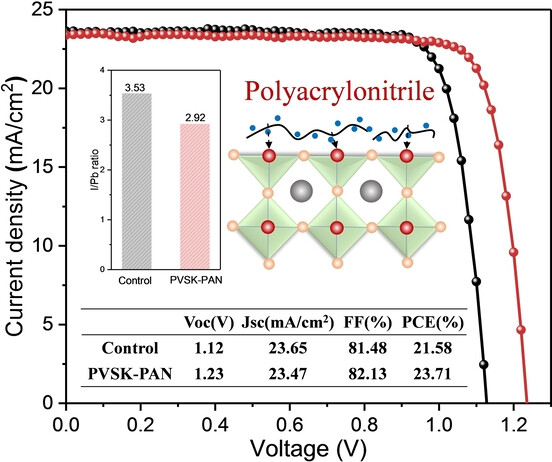
Polyacrylonitrile which has C≡N groups was introduced to passivate the uncoordinated lead cations in perovskite films. The coordination of C≡N with the lead cation was much stronger than that of the normally used C=O group. It could also reduce the I/Pb ratio at the film surface. The device efficiency was improved from 21.58 % to 23.71 %, with the open-circuit voltage enhanced from 1.12 V to 1.23 V.
σ-Donor Ligands | Hot Paper
Geometrically Constrained Cationic Low-Coordinate Tetrylenes: Highly Lewis Acidic σ-Donor Ligands in Catalytic Systems
- First Published: 24 November 2021
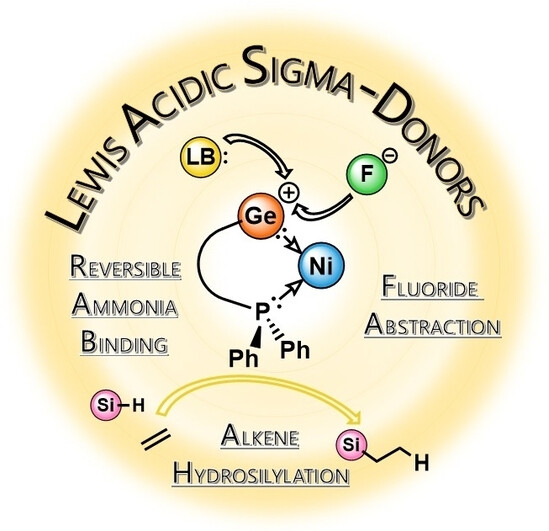
In stark contrast to poorly electrophilic classical σ-donating spectator ligands, we show that geometrically constrained low-coordinate, cationic GeII and SnII ligands remain highly electrophilic in the coordination sphere of Ni0, despite being σ-donors; binding of nucleophiles and fluoride abstraction at the donor atom is demonstrated, alongside the capacity to catalyse the hydrosilylation of alkenes and alkynes.
Colloidal Quantum Dots | Hot Paper
Cutting COF-like C4N to Give Colloidal Quantum Dots: Towards Optical Encryption and Bidirectional Sulfur Chemistry via Functional Group and Edge Effects
- First Published: 07 December 2021
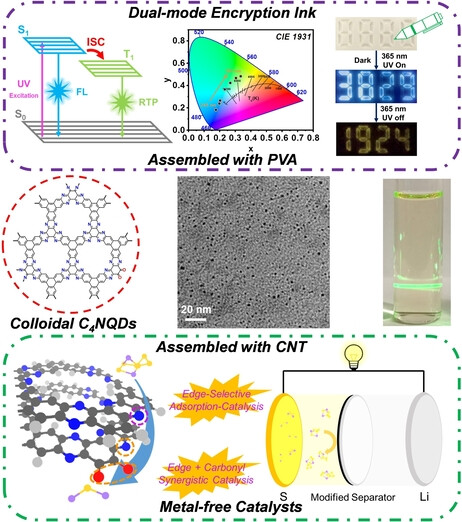
A new class of colloidal carbon-nitride-like quantum dots, C4NQDs, and their functional composites have been introduced. They show interesting fluorescence/room-temperature-phosphorescence dual-mode emission for advanced optical encryption. They also show edge-selective adsorption-catalysis toward sulfur chemistry in Li−S cells by exploiting the functional group and edge effects of quantum dots.
Li-O2 batteries
Spin-State Manipulation of Two-Dimensional Metal–Organic Framework with Enhanced Metal–Oxygen Covalency for Lithium-Oxygen Batteries
- First Published: 18 December 2021
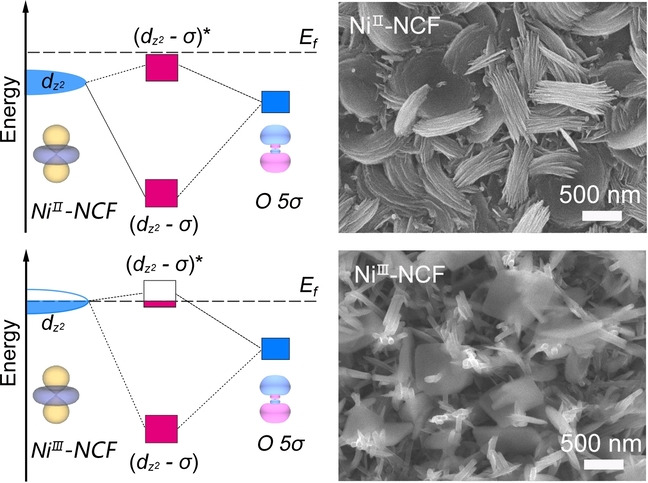
NiIII-NCF with enhanced nickel–oxygen covalency is obtained by manipulating the spin state of Ni2+ in NiII-NCF, which facilitates formation of nanosheet-like Li2O2 among NiIII-NCF nanowire arrays upon discharging. This enables small charge/discharge overvoltages, superior rate capability, and long cycling stability.
Mesoporous Materials
Mesoporosity-Enabled Selectivity of Mesoporous Palladium-Based Nanocrystals Catalysts in Semihydrogenation of Alkynes
- First Published: 16 December 2021
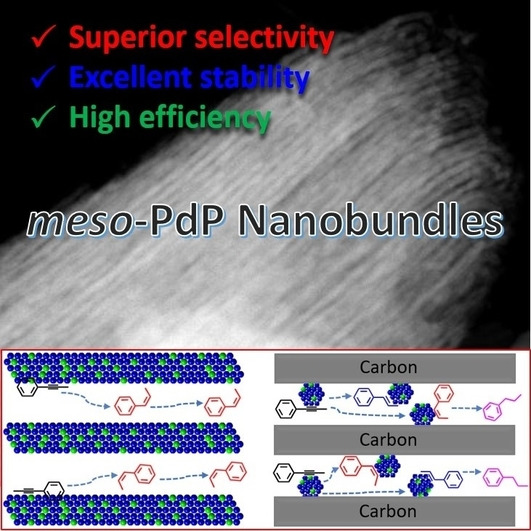
Mesoporosity engineering is demonstrated as an efficient route for boosting catalytic selectivity of Pd-based nanobundle catalysts in the semihydrogenation of alkynes. Mechanistic studies reveal that the continuous crystalline framework and penetrated mesoporous channel of mesoporous Pd-based catalysts synergistically weaken the adsorption and binding strength of alkenes and energetically disable further over-hydrogenation of alkenes to alkanes.
Synthetic Biology | Hot Paper
Regeneration of Phytochemicals by Structure-Driven Organization of Microbial Biosynthetic Steps
- First Published: 20 December 2021

To enable access to hypericin, a phytochemical with promising medicinal properties but low natural abundance, a strategy involving structure-based modification and organization of the microbial biosynthetic steps was developed without knowing its biosynthetic pathway in native plants. The designed consecutive reactions (see scheme) occurred in repurposed cells, thus circumventing the complex plant secondary metabolism.
Copolymers | Hot Paper
One-Step Synthesis of Lignin-Based Triblock Copolymers as High-Temperature and UV-Blocking Thermoplastic Elastomers
- First Published: 13 December 2021

Di-initiating frustrated Lewis pairs promoted compounded sequence control to achieve one-step synthesis of the well-defined triblock copolymers. The resulting thermoplastic elastomers (TPEs) exhibit much superior mechanical properties to those of methyl methacrylate-based TPEs and maintain TPEs properties at temperatures as high as 180 °C.
Cancer Immunotherapy | Hot Paper
Smart Nano-PROTACs Reprogram Tumor Microenvironment for Activatable Photo-metabolic Cancer Immunotherapy
- First Published: 19 December 2021

The smart nano-proteolysis targeting chimeras (nano-PROTACs) are developed for photo-metabolic cancer immunotherapy. SPNCOX-mediated therapy can not only improve tumor immunogenicity but also induce targeted intratumoral degradation of COX-1/2 via the ubiquitin-proteasome system, leading to the depletion of prostaglandin E2 (PGE2) and reprogramming of the immunosuppressive TME to inhibit tumor growth, metastasis, and recurrence.
Upconversion | Hot Paper
Core–Shell Structured Upconversion/Lead-Free Perovskite Nanoparticles for Anticounterfeiting Applications
- First Published: 16 December 2021
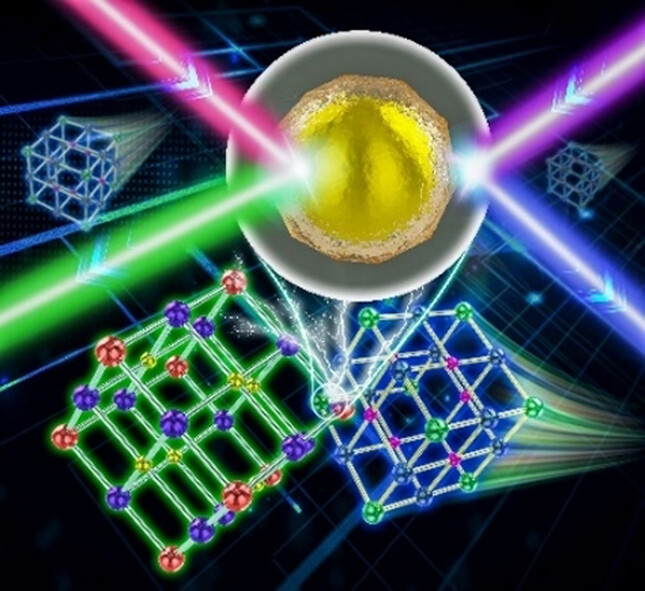
An up-conversion nanoparticles and MnII-based perovskite core–shell heterostructures nanocomposite was successfully synthesized for the first time, which showed dual-color emissions under the excitation of UV light and IR laser. This work suggests its potential in high-quality optical anticounterfeiting.
Batteries | Very Important Paper
Luminescent Materials | Hot Paper
Coordinated Anionic Inorganic Module—An Efficient Approach Towards Highly Efficient Blue-Emitting Copper Halide Ionic Hybrid Structures
- First Published: 02 December 2021
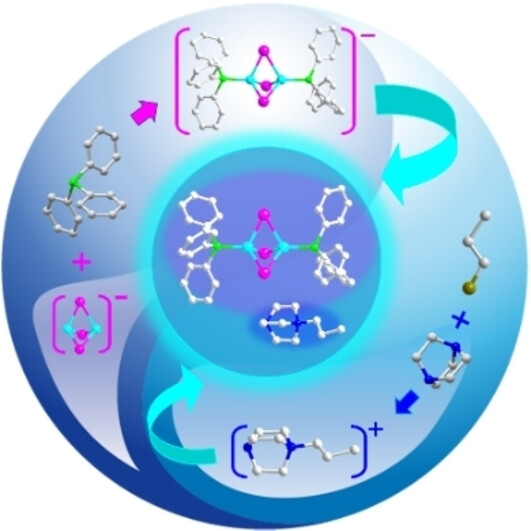
A novel and facile strategy for the design and synthesis of highly luminescent copper halide hybrid structures by fabricating a coordinated anionic inorganic module in these ionic species is reported. By using this approach, a family of strongly blue-emitting copper halide hybrid ionic structures has been prepared with high internal quantum yields (IQYs) up to 98 %.
Helicates
Hindered Tetraphenylethylene Helicates: Chiral Fluorophores with Deep-Blue Emission, Multiple-Color CPL, and Chiral Recognition Ability
- First Published: 13 December 2021
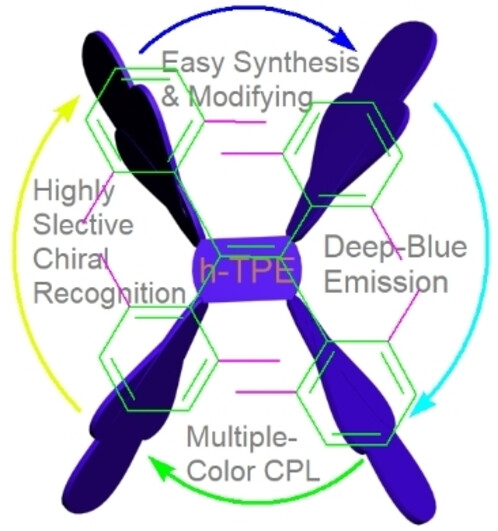
Hindered tetraphenylethylene (TPE) helicates, with a completely immobilized propeller-like conformation through substitution at the 2,6-positions of the phenyl rings, were prepared by a short synthetic route. These helicates, with their many modification positions, show deep-blue to violet emission, circularly polarized luminescence (CPL) that can be tuned over a wide range, and highly enantioselective chiral recognition.
Molecular Qudits
Implementation of Quantum Level Addressability and Geometric Phase Manipulation in Aligned Endohedral Fullerene Qudits
- First Published: 15 December 2021
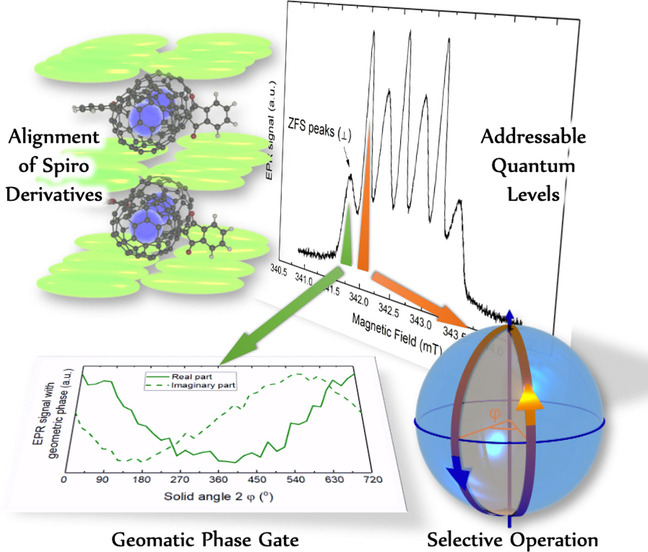
Toward molecular quantum computing, the system needs to have good coherence, scalability, and addressability. Using endohedral nitrogen fullerenes with long coherence time, this work tackled the remaining two challenges by molecular modification and ensemble alignment. The refined molecular system scales up to four addressable quantum levels and enables the first implementation of geometric phase manipulation using pure electron paramagnetic resonance.
Crystal Engineering
Temperature-Reliant Dynamic Properties and Elasto-Plastic to Plastic Crystal (Rotator) Phase Transition in a Metal Oxyacid Salt
- First Published: 10 December 2021
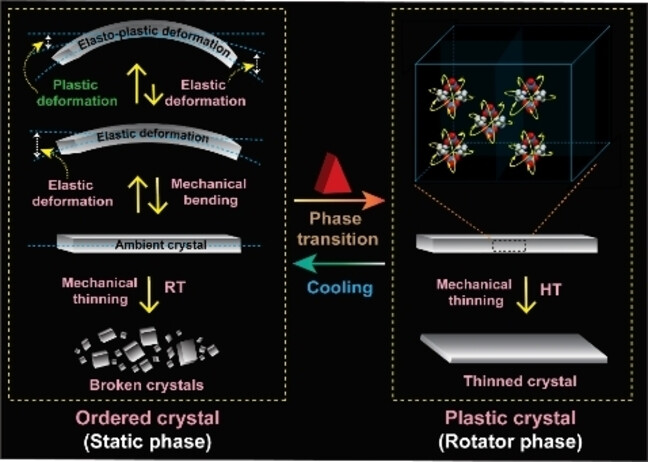
Hierarchical mechanical responses, from elastic and elasto-plastic bending to exceptional malleability, have been realized at different stress and temperature conditions in crystals of a rhenium oxyacid salt. The extent of the molecular rotations/translations in the mechanism is governed by the crystal structure.
Fluoroamides | Hot Paper
TMSCF2Br-Enabled Fluorination–Aminocarbonylation of Aldehydes: Modular Access to α-Fluoroamides
- First Published: 16 December 2021
Supercapacitors | Hot Paper
Microfluidic Fabrication of Hierarchical-Ordered ZIF-L(Zn)@Ti3C2Tx Core–Sheath Fibers for High-Performance Asymmetric Supercapacitors
- First Published: 16 December 2021

High-performance asymmetric supercapacitors based on hierarchical-ordered ZIF−L(Zn)@Ti3C2Tx core–sheath fibers have been developed by microfluidic assembly and microchannel reaction methods. Due to an in situ Ti−O−Zn/Ti−F−Zn bonding bridge, well-developed micro-/mesoporosity and fast interfacial charge transfer, supercapacitors deliver high energy density, large capacitance, long-term stability and natural sunlight-induced self-powered applications.
POMs in Nanotubes | Hot Paper
Stabilization of Polyoxometalate Charge Carriers via Redox-Driven Nanoconfinement in Single-Walled Carbon Nanotubes
- First Published: 17 December 2021
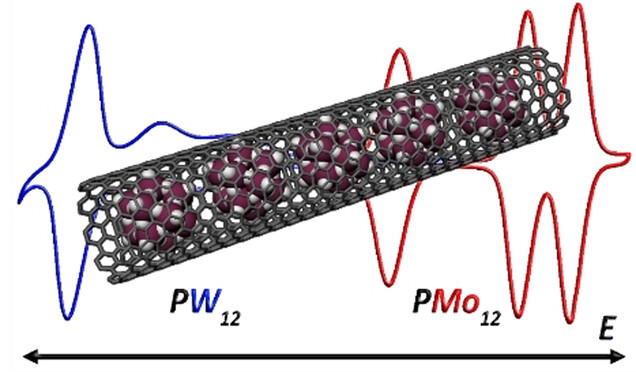
The wide applicability of the redox-driven encapsulation of polyoxometalates (POMs) within single-walled carbon nanotubes is shown, demonstrating that the level of carbon oxidation and the efficacy of the filling are determined by the frontier orbital energies of the POM. Nanoencapsulation is found to confer significant stability to polyoxomolybdates despite their inherent lability.
Luminescent Materials | Hot Paper
A Universal Strategy for Tunable Persistent Luminescent Materials via Radiative Energy Transfer
- First Published: 13 December 2021
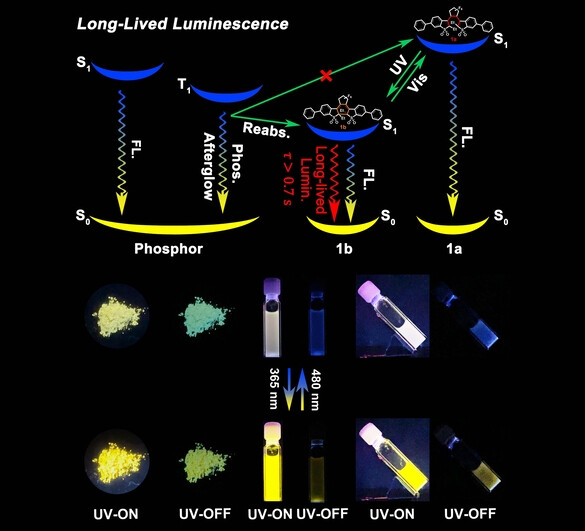
A universal, feasible, and simple approach for dynamic tunable afterglow systems based on a simple radiative energy transfer mechanism is presented. The persistent luminescence (τ>0.7 s) can be reversibly converted between different colors in the solid, solution, and gel states by controlling the isomerization of the energy acceptor through a simple radiative energy transfer (reabsorption) mechanism.
Natural Products | Hot Paper
Aquimarins, Peptide Antibiotics with Amino-Modified C-Termini from a Sponge-Derived Aquimarina sp. Bacterium
- First Published: 17 December 2021
Plasmon Chemistry | Hot Paper
Enhanced Electrochemistry of Single Plasmonic Nanoparticles
- First Published: 10 December 2021
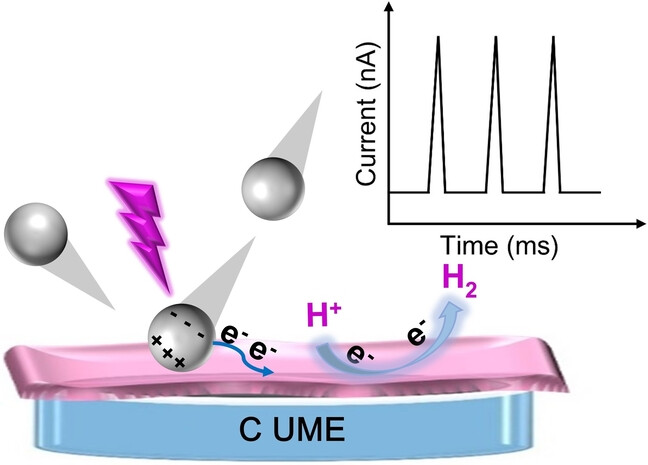
Plasmon-enhanced electrochemistry (PEEC) was systematically investigated on a single nanoparticle level using nanoparticle impact electrochemistry, which enables in-depth understanding of the thermodynamics and kinetics of the system, allowing quantitative analysis of the increased reaction possibility and the decreased activation energy. This work reveals the intrinsic physicochemical information at the nano-confined domains.
Porous Materials
Chemically Engineered Porous Molecular Coatings as Reactive Oxygen Species Generators and Reservoirs for Long-Lasting Self-Cleaning Textiles
- First Published: 20 December 2021

A series of solution-processable, crystalline porous materials were prepared and used as textiles coatings to spontaneously convert absorbed oxygen from air into reactive oxygen species (ROS) upon absorption of daylight, and long-termly store ROS in dark conditions. This work paves the way for further developing self-cleaning textile coatings for the rapid deactivation of highly infectious pathogenic bacteria under both daylight and light-free conditions.
Organolithium Complexes
Supported σ-Complexes of Li−C Bonds from Coordination of Monomeric Molecules of LiCH3, LiCH2CH3 and LiC6H5 to Mo≣Mo Bonds
- First Published: 16 December 2021
Porous Materials | Hot Paper
The First Sulfate-Pillared Hybrid Ultramicroporous Material, SOFOUR-1-Zn, and Its Acetylene Capture Properties
- First Published: 20 December 2021
Chiral Polymers
Molecular Rings
Modification of Multi-Component Building Blocks for Assembling Giant Chiral Lanthanide-Titanium Molecular Rings
- First Published: 18 December 2021
Fluoro-nitrogen Cations | Hot Paper
Fluoro-nitrogen Cations
- First Published: 13 December 2021
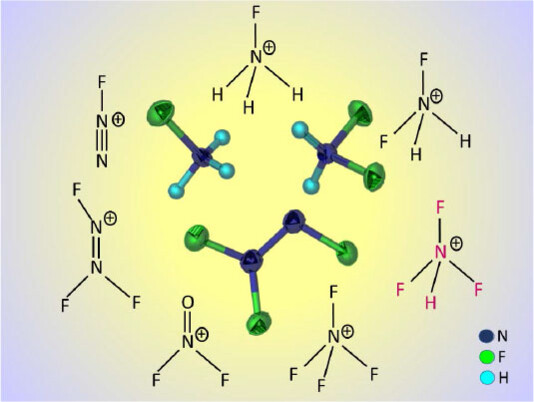
The first structural characterizations of these simple fluoro-nitrogen cations have been accomplished. It is shown that the hybridization of the central nitrogen atom and of the number of fluorine substituents are the determining factors governing the N−F bond lengths which decrease from 1.40 Å to 1.26 Å with increasing fluorine substitution and increasing s-character of the nitrogen atom.
Gas Separation | Very Important Paper
K-Chabazite Zeolite Nanocrystal Aggregates for Highly Efficient Methane Separation
- First Published: 15 December 2021
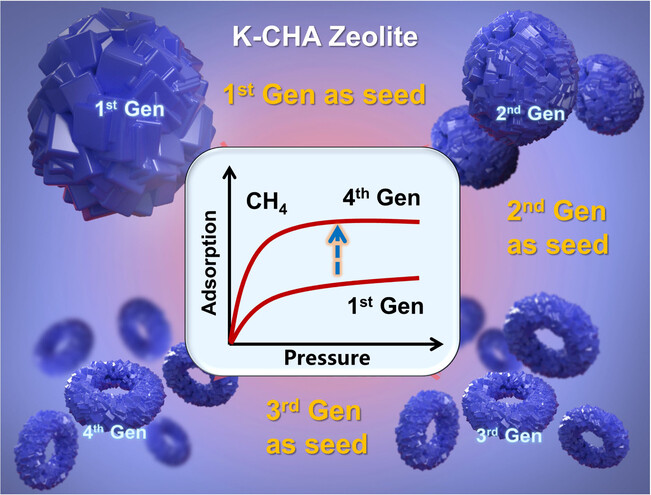
A seed iteration method to synthesize macro–meso–micro hierarchical K-Chabazite nanocrystal (≈50 nm) aggregates with enhanced mass transfer rate and adsorption capacity of CH4 to effectively separate CH4/N2 is reported, which has significant potential for low-concentrated coalbed methane enrichment.
Photochemistry
Cyclodextrins with Multiple Pyrenyl Groups: An Approach to Organic Molecules Exhibiting Bright Excimer Circularly Polarized Luminescence
- First Published: 16 November 2021
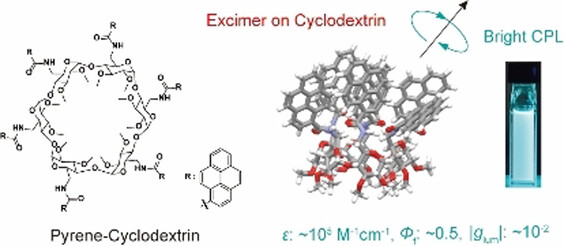
Cyclodextrins with multiple pyrene units exhibited bright circularly polarized luminescence (CPL). Owing to their good molar extinction coefficients (ϵ≈105 M-1 cm-1), polarized emission with a good dissymmetry factor (|glum|≈10-2), and quantum yield (Φf≈0.5), the CPL brightness (BCPL) reached 340 M-1 cm-1.
Metals in Medicine | Very Important Paper
A Carbonic Anhydrase IX (CAIX)-Anchored Rhenium(I) Photosensitizer Evokes Pyroptosis for Enhanced Anti-Tumor Immunity
- First Published: 29 November 2021
Polymere
Multi-Wellenlängen-Photopolymerisation von stabilen Poly(katecholamin)-DNA-Origami-Nanostrukturen
- First Published: 23 November 2021
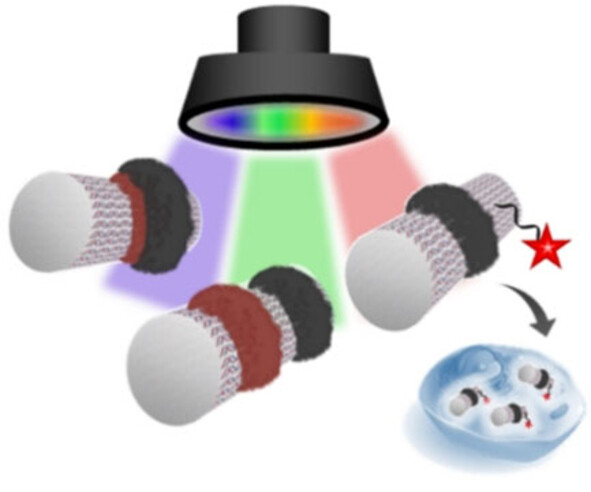
DNA-Origami-Nanostrukturen werden mit lichtempfindlichen Reaktionszentren ausgestattet, die reaktive Sauerstoffspezies bei ihrer charakteristischen Wellenlänge erzeugen. Dadurch wird die Polymerisation der Katecholamine Dopamin und Norepinephrin ausgelöst, sodass die Polymerablagerung auf der DNA-Origami-Vorlage unabhängig gesteuert werden kann. Darüber hinaus verändern die Polymerringe die Wechselwirkung zwischen DNA-Origami-Objekten und Zellmembranen und fördern so deren Aufnahme in die Zellen.




